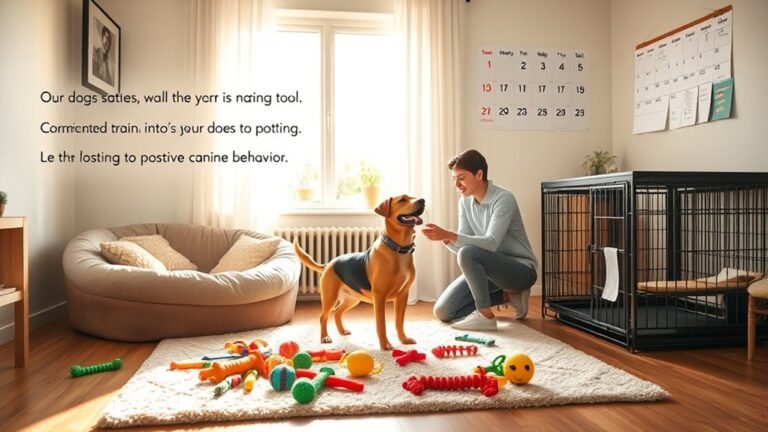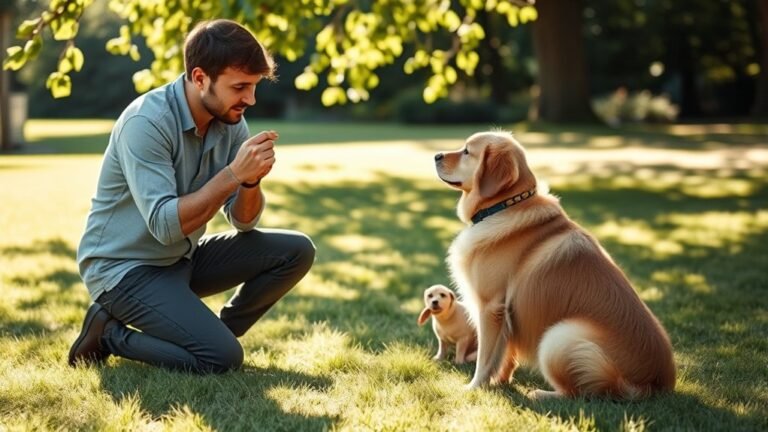10 Stressors That Affect Your Dog
As a dog owner, it's important to know what can stress your dog out. Loud noises, changes in their daily routine, and being left alone can make them anxious. It's helpful to recognize these triggers so you can create a calm home for your pet. But stress can come from other places too. There are hidden things that might be bothering your dog without you even knowing it.
Let's take a closer look at some common stressors that affect our furry friends.
Key Takeaways
- Loud noises, like thunderstorms and fireworks, can scare dogs. This might make them bark too much or want to hide.
- Changes in daily routines, such as different walk times or feeding times, can stress dogs out.
- New places and traveling can make dogs restless as they try to get used to new sights and sounds.
- Many dogs feel anxious when left alone. This can lead to barking, chewing, and accidents in the house.
- Meeting new animals can cause stress. It's important for dogs to have a safe space where they can relax.
Loud Noises and Sudden Sounds
Loud noises and sudden sounds can make dogs feel scared and anxious. Many dogs get very worried during thunderstorms. The loud thunder and bright lightning can frighten them. Because of this fear, dogs might bark a lot, try to hide, or even escape.
Loud music can also upset dogs. It can make their home feel unsafe, which adds to their stress. It's important to notice when these loud sounds happen and how they affect your dog.
You can help your furry friend feel better. Try using calming products. Anxiety wraps can give them a sense of comfort. Sound machines can help drown out the scary noises.
By making your dog's environment peaceful, you can help them feel safe.
Taking care of your dog's needs helps build a stronger bond. A happy, relaxed dog will enjoy their life more!
Changes in Routine
Changes in routine can really affect how your dog feels. When their daily schedule suddenly changes, like if you're busy with work or there are family changes, your dog might feel unsure or anxious.
Dogs love having a steady routine, and things like different walk times or play sessions can make them feel out of sorts.
You might see your dog barking more, acting restless, or even hiding away. To help your dog feel better, try to keep a regular daily schedule as much as you can.
Stick with activities they know and slowly add in any changes. This way, your dog can adjust easily and start to feel calm again.
New Environments and Travel
Taking your dog to new places can sometimes make them anxious or stressed, especially if they're not used to it. You might notice your dog acting restless or hesitant because they're trying to adjust to new smells, sounds, and sights. This can make them feel unsafe.
To help your dog feel better, start by taking short trips. Let them explore at their own speed. Bring along something familiar, like a favorite blanket or toy, to create a safe space during travel.
Make sure your dog meets different people and pets, which will help them feel more at home in new places. By helping your dog deal with their worries, you can both enjoy your time together.
Separation Anxiety
Dogs are great friends, but some can feel very nervous when left alone. This is called separation anxiety. Signs of this can be loud barking, chewing on things they shouldn't, or going to the bathroom inside the house.
Many things can cause this anxiety, like changes in their daily routine, not spending enough time with other dogs or people, or having bad experiences in the past. If you know what makes your dog anxious, you can help them feel better.
There are ways to help your dog. You can use crate training to create a safe space for them. You can also slowly get them used to being alone by leaving for short periods and then making it longer over time.
Giving them fun toys to play with can keep them busy too. Make sure your home feels safe and comfy for your dog.
Helping your dog be strong will make your bond even better. This way, you both feel happy and close to each other.
Conflicts With Other Animals
Dogs can feel stressed when they meet other animals. This stress often comes from social rules and space issues. When your dog sees new animals, it might feel scared or unsure about where it fits in. This can make your dog act aggressively, be scared, or even want to stay away.
To help your dog, watch how it interacts with other pets. Give your dog a safe space to relax, especially when there are other animals around. Introduce your dog to new animals slowly. Encourage positive moments during these meetings.
This can help your dog feel safer and more at home in social situations. A strong sense of security will make your dog more confident and comfortable around other animals.
Lack of Mental Stimulation
Dogs need mental stimulation to stay happy and healthy. Without it, they can feel anxious or bored, and might even start chewing on furniture or doing other naughty things.
To keep your dog's mind active, try playing fun games and using interactive toys. These toys help your dog solve problems and can keep them busy for a long time.
Puzzle games are great too! They challenge your dog and give them a sense of pride when they figure things out.
To keep your dog engaged, switch up the activities every so often. This prevents boredom and keeps things exciting.
Physical Discomfort or Illness
When your dog feels sick or in pain, it can change how they act and feel. It's important to notice if they eat less or seem tired. These signs can help you figure out if something is wrong.
Keeping an eye on your dog's health can help you spot any problems early. This way, you can take them to the vet for help before things get worse.
Keeping your dog comfortable is very important. This might mean giving them medicine or trying other treatments that fit their needs.
Talking to your vet will help you make a plan that works best for your dog. Your care and attention show how much you love them. This strong bond helps your dog feel safe and happy as they recover.
Overcrowded Spaces
Many dogs get stressed in crowded places. This can make them feel anxious and uncomfortable. Busy parks and streets can be too much for some dogs. They might feel scared when there are many people or other animals around. You might see them barking too much, shaking, or trying to hide.
To help your dog feel better, try taking them to quieter places for walks. You can also go out during times when there are fewer people.
At home, make a cozy spot where your dog can relax. This safe space can help reduce their anxiety.
Understanding how your dog feels in crowded situations is important. When you create a calm environment for them, it helps them feel secure.
A happy dog builds a stronger bond with you and feels like they belong.
Unfamiliar People
Meeting new people can stress dogs out. To help your furry friend feel at ease, try some simple socialization tips.
Watch how your dog acts since their body language can tell you what's on their mind. Here are some easy ways to make new faces less scary for your dog:
- Introduce your dog to new people slowly and in safe spaces.
- Use treats or toys to make good memories with strangers.
- Keep an eye on your dog's reactions. If they look worried, take a step back.
- Reward your dog for staying calm when meeting someone new.
With these tips, you can help your dog feel more comfortable around unfamiliar people.
Inconsistent Training Methods
Inconsistent training methods can confuse your dog. When you change how you train, your pup mightn't know what you want from them. This can make them stressed and anxious.
Using positive reinforcement, like treats or praise, helps your dog learn what you want. Being consistent with your commands and rewards builds trust. Your dog needs to feel safe and secure to learn well.
Stick to the same commands and training approaches. Routine makes your dog feel comfortable and confident. It helps them understand what you expect, which can reduce their anxiety.
By being consistent, you strengthen your bond with your furry friend. You both can enjoy a happier and more fulfilling relationship.
Frequently Asked Questions
How Can I Tell if My Dog Is Stressed?
To see if your dog is stressed, watch how they act and their body movements. Signs of stress include barking a lot, hiding, or keeping their tail tucked. When you notice these signs, you can help your dog feel better. It's important to pay attention so you can support your furry friend during tough times.
Are Certain Dog Breeds More Susceptible to Stress?
Some dog breeds feel stress more than others because of their special traits. Knowing about these traits can help you support your dog better. This support can make your dog feel safe and happy at home.
For example, breeds like Border Collies and German Shepherds often get anxious. They need more mental and physical activity. On the other hand, some breeds, like Bulldogs, tend to be more relaxed. Each dog is different, and understanding your dog's nature is important.
By paying attention to how your dog behaves, you can create a cozy spot for them. You can play with them, take them for walks, and just spend time together. All of this helps your dog feel like they belong. Making your dog feel secure will help them be less stressed and more relaxed.
Can Stress Lead to Physical Health Issues in Dogs?
Yes, stress can cause physical health problems in dogs. You might see changes in how your dog acts when they are stressed. It's important to create a loving and safe space for your dog so they feel secure and valued. A happy dog is a healthy dog!
What Are Some Natural Remedies for Dog Stress Relief?
To help your dog feel less stressed, you can try some natural remedies. Herbal supplements like chamomile and valerian root can be good options. They may help your dog calm down and relax.
Another way to create a soothing environment is by playing calming music. Soft sounds can make your dog feel more comfortable and safe in their space. These simple steps may help your furry friend feel better.
How Can I Help My Dog Adjust to New Experiences?
Help your dog get used to new things with some simple steps. Start by showing them new sights and sounds slowly. Take your time and reward your dog when they do well. If they seem scared, offer them comfort and stay close. This way, your dog can build confidence and feel safe with you. Enjoy this time together!







